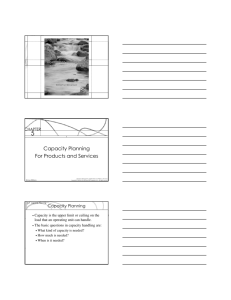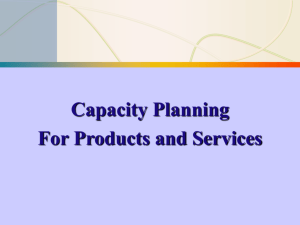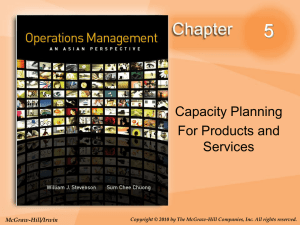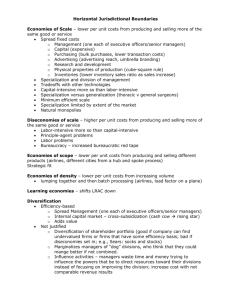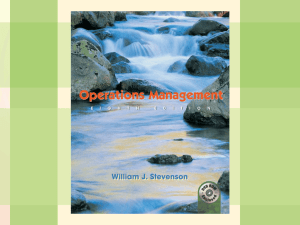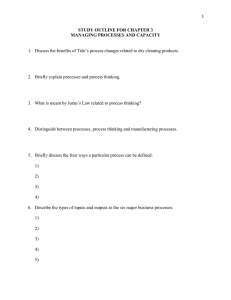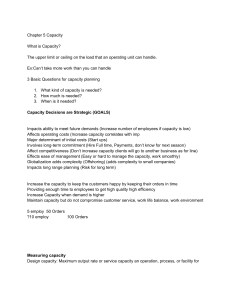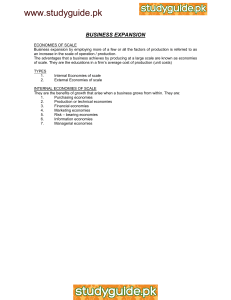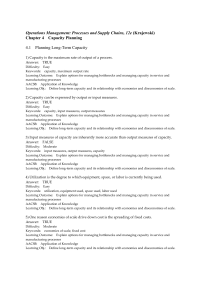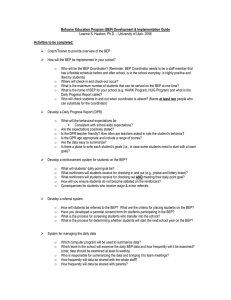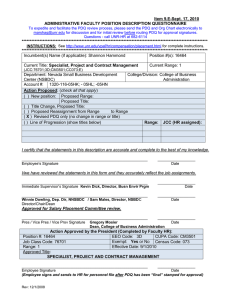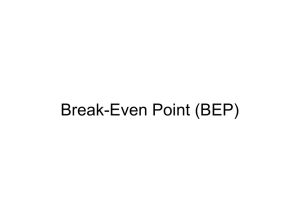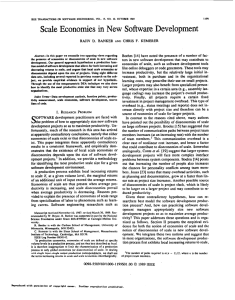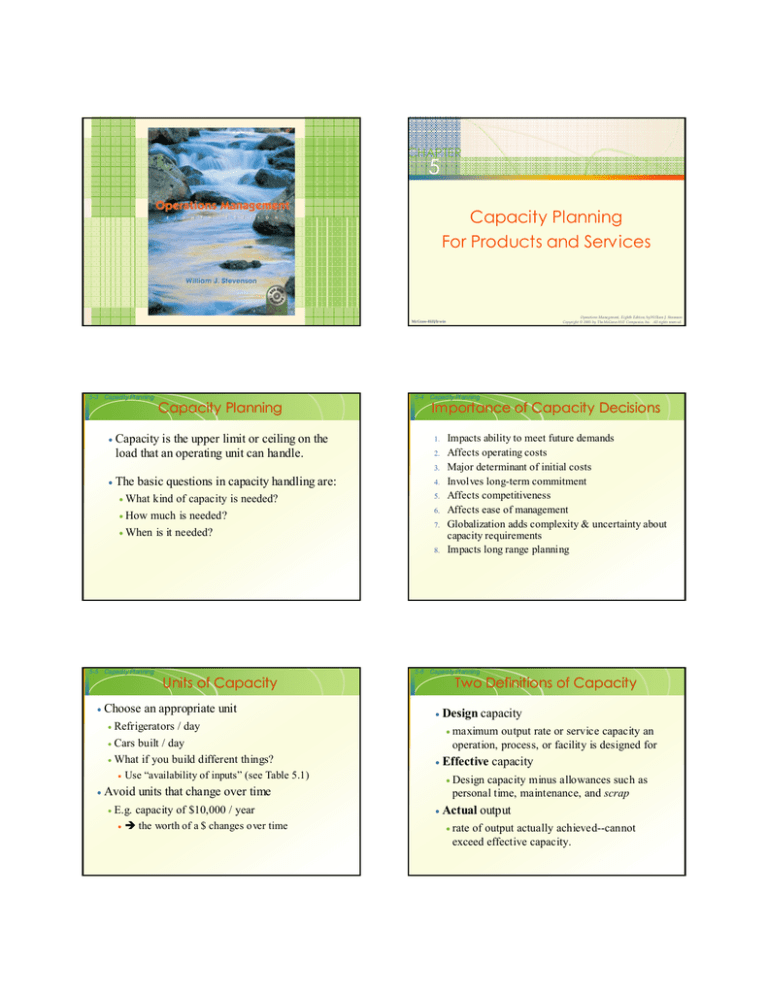
5-1 Capacity Planning
5-2 Capacity Planning
CHAPTER
Operations Management
5
Capacity Planning
For Products and Services
William J. Stevenson
8 th edition
Operations Management, Eighth Edition, by William J. Stevenson
Copyright © 2005 by The McGraw-Hill Companies, Inc. All rights reserv ed.
McGraw-Hill/Ir win
5-3 Capacity Planning
•
Capacity Planning
Capacity is the upper limit or ceiling on the
load that an operating unit can handle.
5-4 Capacity Planning
Importance of Capacity Decisions
1.
2.
3.
•
The basic questions in capacity handling are:
• What
kind of capacity is needed?
• How much is needed?
• When is it needed?
4.
5.
6.
7.
8.
5-5 Capacity Planning
•
Units of Capacity
Choose an appropriate unit
5-6 Capacity Planning
Two Definitions of Capacity
•
•
Refrigerators / day
• Cars built / day
• What if you build different things?
•
•
output rate or service capacity an
operation, process, or facility is designed for
•
Use “availability of inputs” (see Table 5.1)
E.g. capacity of $10,000 / year
•
Î the worth of a $ changes over time
Design capacity
• maximum
Effective capacity
• Design
capacity minus allowances such as
personal time, maintenance, and scrap
Avoid units that change over time
•
Impacts ability to meet future demands
Affects operating costs
Major determinant of initial costs
Involves long-term commitment
Affects competitiveness
Affects ease of management
Globalization adds complexity & uncertainty about
capacity requirements
Impacts long range planning
•
Actual output
• rate
of output actually achieved--cannot
exceed effective capacity.
5-7 Capacity Planning
Efficiency and Utilization
Efficiency =
5-8 Capacity Planning
Efficiency/Utilization Example
Actual output
Design capacity = 50 trucks/day
Effective capacity
Effective capacity = 40 trucks/day
Actual output = 36 units/day
Actual output
Utilization =
Actual output
Design capacity
=
36 units/day
Efficiency =
= 90%
Effective capacity
Both measures expressed as percentages
Utilization =
Actual output
40 units/ day
=
Design capacity
5-9 Capacity Planning
Determinants of Effective Capacity
5-10 Capacity Planning
Ca pa city =
•
•
•
•
•
•
•
Facilities (location, layout, etc)
Product and service factors (limited products /
services Î more efficiency)
Process factors (effect of quality reqs.)
Human factors (motivation)
Operational factors (bottlenecks)
Supply chain factors (effect of changes on the supply
chain)
External factors (EPA, unions)
Product
#1
#2
#3
•
= 72%
Example 2 (pg 177)
2000
Annual
Demand
400
300
700
Cl ea r
Standard
Proc essing
Time
5
8
2
Tota l =
•
36 units/day
50 units/day
Proce ssing
Time
Needed
2000
2400
1400
Proces s
Requirements
1
1.2
0.7
5800
2.9
Capacity per machine is 2000 hours per year
Three products’ demands are listed
•
How much capacity (in machine hours per year) are needed
to cover this forecast? Î How many machines needed?
See Table 5.2 in text
5-11 Capacity Planning
Homework Due M onday before class
•
•
Page 192, problems 1, 2 and 5
I will provide “feedback” on your problem solving
technique
•
At this time: The HW grade is not posted nor
included in final grade
5-12 Capacity Planning
Make or Buy
Having determined capacity required do you make or
buy? Factors affecting this decision are:
5.
Available capacity
Lack of expertise
Quality considerations for special items
Nature of demand (unusual demand)
Cost (fixed & per-unit)
6.
Risk (loss of control?)
1.
2.
3.
4.
•
Cost-Volume analysis, See solved problem #1
5-13 Capacity Planning
Economies of Scale (Optimal Operating Levels)
5-14 Capacity Planning
Evaluating Alternatives
•
Economies of scale
•
•
Average cost per unit
Figure 5.3
If the output rate is less than the optimal level,
increasing output rate results in decreasing
average unit costs
Diseconomies of scale
•
If the output rate is more than the optimal level,
increasing the output rate results in increasing
average unit costs
Production units have an optimal rate of output for
minimal cost.
Minimum average cost per unit
Minim um
cost
0
Rate of output
Fixed cost spread out over fewer units Å | Æ machine breakdown, worker fatigue, etc.
Economies of scale Å Æ diseconomies of scale
5-15 Capacity Planning
Evaluating Alternatives
Figure 5.4
Average cost per unit
Minim um cost & optimal operating rate are
functions of size of pr oduction unit.
0
Small
plant
Medium
plant
Large
plant
Output rate
5-16 Capacity Planning
Cost--Volume Equations
Cost
Profit = Total_Revenue – Total_Costs
P = TR – TC
TR = Revenue/unit * #_units = R * Q
TC = Fixed_costs + variable_cost/unit * #_units
TC = FC + v * Q
Profit = P = Q ( R – v ) – FC
Required Volume Q for a profit P is
Q = (P+FC)/ (R-v)
QBEP = FC / (R-v)
Larger plants have a higher minimum point ( more economies of scale)
5-17 Capacity Planning
Assumptions of CostCost-Volume Analysis
5-18 Capacity Planning
Cost--Volume Relationships
Cost
1.
2.
3.
4.
5.
6.
One product is involved
Everything produced can be sold
Variable cost per unit is the same regardless
of volume
Fixed costs do not change with volume
Revenue per unit constant with volume
Revenue per unit exceeds variable cost per
unit
Amount ($)
Figure 5.5a
0
C
+F
C)
VC
=
t (V
t
os
os
c
c
le
t al
ab
To
ari
v
t al
To
Fixed cost (FC)
Q (volume in units)
5-19 Capacity Planning
5-20 Capacity Planning
Figure 5.5b
Figure 5.5c
Cost--Volume Relationships
Cost
0
ue
e
nu
f it
ve
e
r
Pro
al
t
t
cos
To
t al
To
Amount ($)
Amount ($)
n
ve
re
l
ta
To
Cost--Volume Relationships
Cost
0
Q (volume in units)
5-21 Capacity Planning
BEP units
Q (volume in units)
5-22 Capacity Planning
Break--Even Problem with Step Fixed Costs
Break
Figure 5.6a
Break--Even Problem with Step Fixed Costs
Break
Figure 5.6b
+V
FC
How many machines
should w e purchase
(or set up for running)?
# of machines
purchased/running
affects your fixed costs
in a stepped (discrete)
fashion.
+
FC
FC
+V
C=
V
C=
TC
$
BEP
3
TC
C=
TC
BEP2
TC
3 machines
3
TC
TC
2 machines
2
TR 1
1 machine
Quantity
Quantity
Multiple break-even points
Step fixed costs and variable costs.
The BEP needs to be calculated separately for each number of machines (then
compare it to the capability of the machine(s) or the anticipated demand levels).
5-23 Capacity Planning
Financial Analysis
•
Cash Flow - the difference between cash received
from sales and other sources, and cash outflow for
labor, material, overhead, and taxes.
•
Present Value - the sum, in current value, of all
future cash flows of an investment proposal.
•
Is $1000 received today =, <, or > $1100 received in
two years?
•
Depends on interest rate (which is typically uncertain
over a period of time)
5-24 Capacity Planning
•
Supplement to Ch 5




